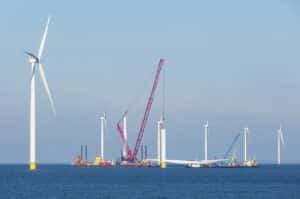
A wind farm under construction off the Dutch coast in 2016. Development of major offshore wind turbine projects south of Martha’s Vineyard should be in high gear by 2023.
The state’s electric utilities and the Baker administration are back in the market for another offshore wind contract, this time seeking up to twice as much power as in previous rounds.
Under a request for proposals released Friday, bids are due by Sept. 16, with plans to select the winning bid or bids Dec. 17 and have contracts filed with the Department of Public Utilities by April 27, 2022.
The 140-page RFP seeks bids of “at least 400 MW and up to 1600 MW of Offshore Wind Energy Generation,” and says the evaluation team will consider proposals of at least 200 megawatts. It says there is no preferred bid size.
A 1,600 megawatt procurement would just about double the amount of energy that Massachusetts utilities have contracted for so far since a 2016 clean energy law kicked off the state’s foray into the offshore wind world. Two projects, Vineyard Wind I and Mayflower Wind, are under contract for roughly 1,600 megawatts combined.
New Bedford officials hope to ignite further industrial development in the city and surrounding area to support the turbines and manufacture components for them. The Eastern Massachusetts industrial real estate market is already one of the hottest in the state.
State energy officials said last year that one larger solicitation, rather than two procurement rounds of 800 MW each, “would give developers maximum flexibility to use transmission infrastructure efficiently, thereby helping ensure the Commonwealth receives the best possible suite of bids that minimize the environmental and socioeconomic impacts of siting offshore wind structures in the ocean and on land and achieve many of the potential benefits of the independent transmission solicitation without the added costs and risks.”
Officials from the Department of Energy Resources, attorney general’s office and the electric distribution companies – Unitil, National Grid and Eversource – published a draft RFP in March, and the drafting team received comments from 23 stakeholders that the administration said prompted revisions strengthening criteria around environmental justice, diversity and inclusion.
For the first time, the administration said, the RFP will require bidders to submit diversity, equity and inclusion plans, including a workforce diversity plan and a supplier diversity program plan. The RFP also asks bidders to describe potential positive and negative impacts on environmental justice populations and host communities.
“This new solicitation will not only procure more affordable offshore wind energy for residents than ever before, but will also direct greater investment in economic development while requiring offshore wind developers to create comprehensive plans to ensure the Commonwealth’s environmental justice and minority communities share equitably in the benefits of this growing industry,” Energy and Environmental Affairs Secretary Kathleen Theoharides said in a statement.
Theoharides described wind power as a “critical backbone” of clean energy efforts in Massachusetts. She said the new solicitation increases the emphasis on economic development in the scoring of contracts and aims to “build a workforce that’s representative of the people of the commonwealth.”
The solicitation says that the nominal levelized price of any proposal must be less than $77.76 per megawatt hour, in keeping with the DOER’s interpretation of an offshore wind price cap, put in place by the 2016 energy law, that restricts the price of power from new procurements to no higher than the price of the previous contract.
Between the 2016 law and a 2018 law, Massachusetts lawmakers authorized the procurement of a total of 3,200 megawatts of offshore wind power, a threshold that would be reached by a new 1,600 megawatts procurement. A climate bill Gov. Charlie Baker signed in March authorizes an additional 2,400 megawatts of offshore wind energy by 2027.




 |
| 

